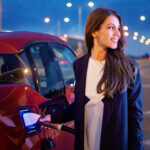TL;DR
The car determines the maximum charge rate up to the limit of the electric vehicle supply equipment (EVSE). A Level 1 (L1) EVSE will charge your car over the weekend, perhaps longer. A Level 2 (L2) EVSE will charge your car overnight. A DC Fast Charger (DCFC) charges your car in a matter of minutes while you wait. A DCFC can add 100 miles or more during a quick restroom break in the right conditions and with the right car.
The Nitty-Gritty Details
First, let’s define the equipment. What exactly is an EVSE? What is a car charger? Electric vehicle supply equipment (EVSE) is really just a fancy switch. The thing that comes with most cars, which you plug into the wall and then plug into your car, is formally known as a Level 1 EVSE. Purists will blanch at hearing it referred to as a “charger.” Some higher-end vehicles will come with a portable L2 EVSE. In most cases on this website, we’ll stick to calling it what it is –an EVSE– but feel free to call it a charger if you want. You do you. (The charger is actually on the car itself, and will be the topic of a future column.)
Now that we have established the difference between an EVSE and a charger, what is the difference in the levels?
What does L1 mean?

An example of an L1 EVSE. This unit came with a Hyundai Ioniq 5. Note that it has a “standard household” plug, more formally called a NEMA 5-15. Typically, L1 EVSEs are used in emergencies, not for day-to-day charging. Photo credit: John Higham.
An L1 EVSE operates at a voltage of 120V and is formally known as a NEMA 5-15 plug– what any American would recognize as a standard plug. This is (most likely) what came with your car. (Europeans may snicker because their main electrical supply is 240V, and what would have come with their vehicle is technically an L2.)
L1 EVSEs will typically have a maximum current rating of 12 amps. Power is measured in watts, and is calculated by volts multiplied by amps, which in the case of the EVSE above is 120 times 12 or 1440 Watts (or 1.4 kW). Using this for an hour will put 1.4 kWh of energy back into your car. The battery of a modern EV can have a capacity of 50 kWh or even 100 kWh. Charging a 100 kWh battery using a L1 (1.4 kW) charger can therefore take around 71 hours to charge from empty completely. That’s not ideal for overnight charging if you need to put a lot of energy back into your car.
How is L2 different from L1?
Most EV owners opt for a dedicated L2 EVSE installed near the place they park their cars. An L2 operates at 240V, so it has twice the voltage of an L1 but more than twice the power because any dedicated L2 EVSE will operate at more than 12 amps. Common power ratings for L2 EVSE are 7.2 kW and 9.6 kW, corresponding to 32 amps or 40 amps at 240 volts, but there are also L2 EVSE that operate at 5.7 kW and 11.5 kW.
The saying “bigger is always better” doesn’t apply here because there are some excellent reasons why someone could legitimately conclude that 5.7 kW is perfectly fine and that 11.2 kW is a waste of money. To explain why requires more background, so we’ll have to go a bit deeper.
By (US-centric) code as determined by the National Electrical Code (NEC), any dedicated EVSE needs to be installed on its own dedicated circuit. If you’ve ever tried to determine which circuit breaker in your house tripped, you know that lights and electrical sockets share a breaker. If a breaker trips in the kitchen, it’s possible that all the lights and (110V) appliances in the kitchen are dead. Continuing with the kitchen example, you may have noticed that your stove and oven (operating at 240 V) didn’t trip. That’s because, per the NEC, these high-power devices each require a dedicated circuit.
The NEC also requires that for loads designed to operate “continuously” (defined as three hours or longer), the circuit must be derated to 80% of its maximum. EVSEs fall into this category and must be installed on a dedicated and derated circuit. Common circuit breaker sizes are 30, 40, 50, and 60 amps. After calculating power and accounting for the 80% derating, it suddenly makes sense why EVSEs have power ratings of 5.7, 7.2, 9.6, and 11.5 kW. Fun fact– the 12 amp maximum on an L1 is due to its NEMA 5-15 plug being rated for 15 amps, but since it is a continuously operating device that must be derated, 80% of 15 is 12 amps.
Common usage for 240V plugs are clothes dryers (30 amps) and ovens, welders, and RVs (50 amps). If you have a dryer in your garage, you may want to consider installing a 5.7 kW EVSE. Some devices will let you use the dryer, and as soon as the dryer turns off, the devices will switch the circuit back to allow your car to charge. Charging at 5.7 kW will replenish 57 kWh of energy in your car’s battery during a 10-hour overnight charging session. That’s good for roughly 150 miles for many EVs. If that meets your needs, perfect. In the early days of EVs, many people (myself included) took their EVSE on the road and sought out RV parks that would typically have a 50 amp plug (known as a NEMA 14-50) available.
I began this article by saying that the EVSE is fancy– because it’s a smart switch. That is important because the car controls the charge rate up to the maximum capability of the EVSE. Always. When you plug your car in, there is communication between the car and the EVSE that goes something like this:
- Car– Evening. I’m ready to start charging. I’m good for 9.6 kW.
- EVSE– Not so fast. I max out at 7.2 kW.
- Car– Whatever. Just give me what you got.
And so it goes until the battery begins to near 100% state of charge, when the car will slowly request less and less power. But that’s a topic for another day.
This is important to mention because if your car only charges up to 7.2 kW, you may not want to spend the extra money installing the 11.2 kW EVSE, for example. There is such a thing as future proofing, but that’s between you and your wallet.
What is a DCFC?

A 2019 Jaguar I-Pace charging using a DCFC. Early adopters were ecstatic when EVs, like the Jaguar, could finally charge at rates of 100 kW. Photo credit: John Higham.
First, let’s start with a quick discussion of alternating current (AC) and direct current (DC). AC polarity changes from positive to negative 60 times per second, at least in North America. DC never reverses polarity. Edison and Tesla famously fought over which standard (AC or DC) was better. Tesla won but never got the credit he deserved until Benedict Cumberbatch starred in The Current Wars in 2017.
The important bit here is that AC is what comes out of your wall, but the battery operates on DC. So your car has an onboard charger that converts the AC to DC. This onboard charger is what limits your car’s ability to charge while plugged into an L2 EVSE.
None of that applies to DCFC because it is DC, so it bypasses your onboard charger, and what comes out of the DCFC is more or less dumped straight to the battery. The device itself (the DCFC) is actually the charger, so it’s proper to call it such.
When using DCFC, the limiting factor in your car’s charge rate is no longer its onboard charger but your car’s ability to manage the heat generated by the charging process.
Similarly to AC charging using L2, the car controls the charge rate up to the maximum capability of the DCFC. Always. Now the communication between the car and the DCFC might go something like this:
- Car– Morning. I’m ready to start charging and I’m in a bit of a rush as I’m trying to get to Vegas before the March Madness opening bell. I’m good for 50 kW.
- EVSE– Wait, why are you here? I’m good for 350 kW. You really should have plugged in next door at the low-powered units.
- Car– Doh!
Seriously, if your car isn’t capable of accepting higher charge rates, refraining from using them is considered proper etiquette in the EV community and is much appreciated. Sometimes those are in use or out of commission, so c’est la vie. A modern EV on a high-power DCFC can add 100 miles in just a few minutes.
Let me point out a couple more points about DCFC before I back away from the keyboard on what I thought would be a short subject. The cables on high-power DCFC are liquid-cooled and, as such, can be really heavy and stiff, so it isn’t your imagination. Try to get as close as possible without needing a lot of twisting to reorient the cable. I know, easier said than done.
Secondly, there is a tremendous amount of power running through that cable. There are several layers of safety in place to protect the consumer, and one of those is locking the plug to the car. If one were to unplug while the charge session was still active, there would be more than enough power to weld that plug to the car. As such, the plug must be locked to the car before the session starts, and the DCFC queries the vehicle about the status. The car controls the charge session, and if the car doesn’t report that the plug is locked, the charge session will not initiate.
If you listen closely, you can hear the locking mechanism engage on most EVs. Many (all?) early EVs and DCFCs had less than robust locking mechanisms, frustrating many drivers of that era. One workaround was to off-load the cable sag by lifting gently on the plug until you heard the lock engage. I really hope that in 2023 we’ve fixed this problem, but sh!t happens. So if you don’t hear the lock engage, feel free to gently lift the cable until it does.
Next week we’ll discuss reasons to consider your first EV purchase.









0 Comments